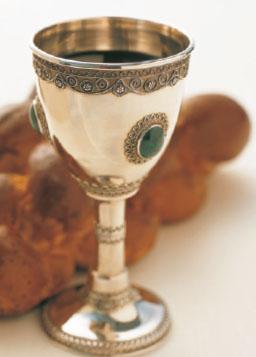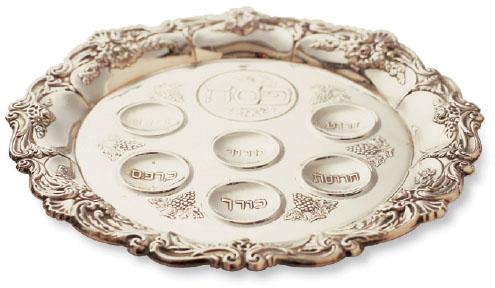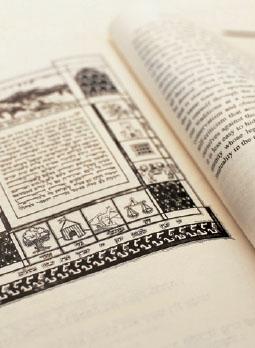Kosher and Traditional Jewish Cooking: Authentic Recipes From a Classic Culinary Heritage: 130 Delicious Dishes Shown in 220 Stunning Photographs (38 page)
Authors: Marlena Spieler

The ceremonial
shofar
(ram’s horn) is blown at Rosh Hashanah to welcome in the New Year.
The Jewish year begins in September or October with Rosh Hashanah, which means the head of the year. This is the start of the Ten Days of Penitence, also called the Days of Awe, which end with Yom Kippur. Jews are encouraged to spend these days in retrospection, considering their behaviour and how to make amends, improving their own lives and the lives of those around them.
The holidays of Rosh Hashanah and Yom Kippur are often referred to as the High Holy Days, and many Jews consider them so important that even if they observe no other festivals in the year, at this time they will go to synagogue, partake of a festive meal, and recite the prayers and blessings.
A ceremonial
shofar
(ram’s horn) is blown on Rosh Hashanah, as it is on Yom Kippur. The haunting sounds of the
shofar
reminds Jews of their long history and of the ancient convenant between the people of Israel and God.
Rosh Hashanah begins, as usual, at sundown on the evening before. Candles are lit, the bread is blessed, and the Kiddush is recited over the wine. A festive meal is prepared. This includes sweet foods such as apples dipped in honey, bringing the promise of sweetness in the year ahead. The challah, which is shaped into a round, rather than the more familiar oval plait, is studded with raisins or small sweets (candies). Honey replaces salt for the blessing of the challah.

Shabbat begins with the blessings being said over a loaf of challah and a cup of wine.
The 10th day of Tishri, the first month in the Jewish calendar, is Yom Kippur – the Day of Atonement. It is the most solemn day of the year and marks God’s forgiveness of the Israelites after they worshipped the golden calf while Moses received the tablets of the law from God on Mount Sinai.
The meal on the eve of Yom Kippur is eaten in the afternoon, before sunset. Chicken soup is the preferred food, as it is for almost every festive occasion. For Ashkenazi Jews it is traditional to eat the soup with knaidlach (matzo balls) or kreplach filled with chicken, while for Sephardi Jews there are many variations.
All foods eaten at this time must be simple and not too salty or spicy as it is difficult to fast with a raging thirst. It is intended that penitents should feel a few hunger pangs while they are fasting, but they should not get into any difficulty during this period.
Families and friends gather together for celebrations to break the fast after Yom Kippur. It is a happy occasion after the solemnity of the day’s observance. Sephardim serve eggs, the symbol of life, and almost all Jews enjoy sweet foods such as honey cake and fruit.
Dishes are prepared the day before Yom Kippur so that they are ready for the end of the fast. For Ashkenazi Jews, it is a good time to eat bagels, cream cheese, lox (smoked salmon), kugels and herring. A break-the-fast party is much like a brunch, but with a feeling of lightness of soul and a spirit of looking forward to the new year.
This festival is observed by building a
sukkah
, which is a temporary three-sided hut. If the weather permits, meals during the seven-day festival are eaten in the
sukkah
. Four plants – Arba Minim – decorate the
sukkah
. They are: the etrog (a lemon-like citron); the lulav (palm branch); the arava (willow branch); and the myrtle. Each of these has a deep significance. The etrog is shaped like a heart and symbolizes the hope of divine forgiveness for the desires of our heart; the lulav symbolizes Israel’s loyalty to God; while the myrtle is shaped like an eye and represents the hope that greed and envy will be forgiven. The arava is shaped like a mouth and represents forgiveness for idle talk and lies.

Children spin the dreidel as part of the Chanukkah celebrations.
Since Sukkot is a harvest festival, fruit and vegetables are eaten. Cabbage is stuffed to make holishkes, and strudel is made from apple. Pomegranates and persimmons are considered a Sukkot treat.
The eighth day of Sukkot is Shemeni Atzeret, when memorial prayers are said. The next day, Simchat Torah, is the festival of rejoicing in the Torah, when the weekly readings of the Torah in the synagogue finish and the cycle begins again. Children are often brought to the synagogue to celebrate Simchat Torah.
Throughout the world, beginning on the eve of the 25th of Kislev, which falls in November or December, Jews celebrate Chanukkah, the festival of lights, by lighting an oil lamp or menorah filled with candles, lighting one every night for eight nights until all are lit.
The festival commemorates the Maccabean victory over Antiochus IV in the year 165
BCE
(
BC
). When the Jewish Maccabees returned to the Temple, after defeating the Syrians, they found it pillaged, and the eternal light extinguished. They lit the lamp, but there was only enough oil for one day. However a miracle occurred and the holy lamp continued to burn for eight days until a messenger returned with a new supply of oil.
At Chanukkah, Jews eat foods cooked in oil, to remind them of the lamp that burned and burned. Chanukkah is a happy and joyous celebration. The Shulhkan Arukh – the code of law – forbids mourning and fasting during this time, encouraging great merry-making.
This festival is one of celebration, feasting and drinking. It falls on the 14th Adar, around February or March, and reminds Jews of the triumph of freedom and goodness over evil. Special foods are eaten at Purim.
In Ashkenazi cultures, triangular pastries filled with nuts or dried fruit are served. The filling is meant to commemorate Esther, who ate only fruits and nuts in the palace, as the kitchen was not kosher. For North African Sephardim, fried pastries drenched in honey and sprinkled with nuts, called oznei Haman (the ears of Haman), are a favourite Purim treat.
The Passover festival, Pesach, is one of the biggest festivals in the Jewish year. It commemorates the story of the exodus of the Hebrew slaves from Egypt, a flight that turned a tribe of slaves into a cohesive people. During this festival, Jews celebrate the flight for freedom of all humanity – the freedom of spirit as well as personal, religious and physical freedom.
Pesach falls sometime around March or April. The word pesach means passing over, and represents the passing over of the houses whose doorways the Israelites had splashed with lamb’s blood, so that those inside remained unharmed when the angel of death ravaged Egypt, slaying the first-born sons.
For eight days no leavened foods are permitted, ruling out breads made with yeast. Crisp flat breads called matzos are served, as a reminder of the Israelites who in their escape to the desert, only had time to make flatbreads, cooked on hot stones.

A ritual Seder plate.
On the first night of the festival a ritual meal called the Seder is served. The meal revolves around the reading of the Haggadah, the story of the exodus from Egypt and from slavery.
Between Pesach and the next major festival, Shavuot, is a period called Sefirah. It is a solemn time of observance rather than a festival. Beginning at the end of Pesach, it commemorates the day when a sheaf of young barley – the Omer – was traditionally brought into the Temple in Jerusalem.
Observing this period is called Counting the Omer. During this time, the Observant do not celebrate weddings, have other celebrations or even cut their hair.
This happy day falls on the 33rd day of counting and is the one break in the solemn time of Sefirah. Lag b’Omer is a day made for celebrating out of doors and picnicking. For Observant Jews, Lag b’Omer is the day in spring when you could schedule a wedding or have a haircut.
This festival is known as the Holiday of the Trees. It is one of the four holidays that celebrate nature, as mentioned in the Mishnah (part of the Talmud). Tu b’Shevat occurs in February, when the sap begins to rise in the fruit trees of Israel. To celebrate, it is customary to eat different kinds of fruits and nuts.

Prayers for Shavuot.
The word
shavuot
means weeks in Hebrew, as this festival comes seven weeks after Pesach. In English it is known as Pentecost, which comes from the Greek, meaning 50 days. It is also sometimes referred to as the Festival of the Torah, as it tells the story of the Israelites wandering through the desert and commemorates the giving of the Jewish scriptures, the Torah, and the Ten Commandments to Moses. This festival is also the Feast of the First Fruits, one of the ancient pilgrimages to Jerusalem, when the first fruits and grains of the season were brought as offerings.
of
Kashrut
Kashrut is the set of ritual dietary laws that are set out in the Talmud. Food that conforms to those standards is described as kosher. Whether a Jew comes from a land where onions, garlic and chicken fat are freely eaten, or one whose cuisine includes hot peppers, spices and olive oil, the meals eaten in the Observant Jewish household will not taste the same as food prepared from similar ingredients by non-Jewish neighbours, because the former will conform to the rules of Kashrut.
